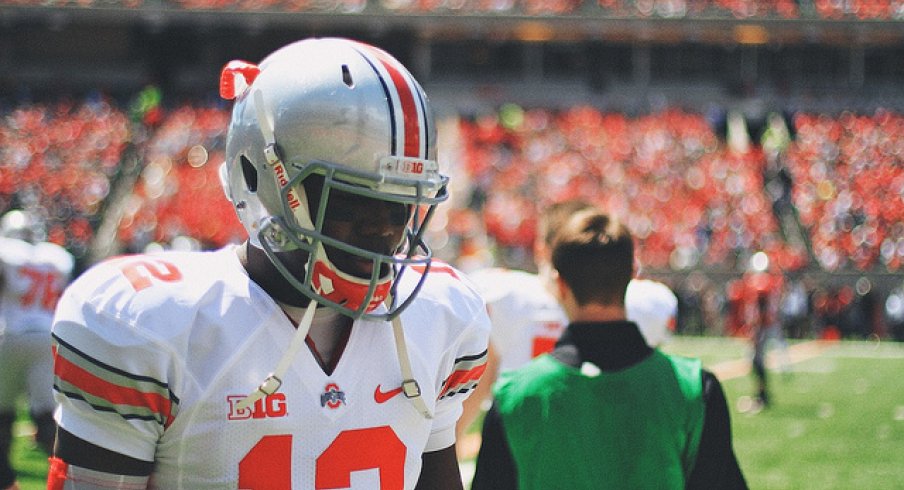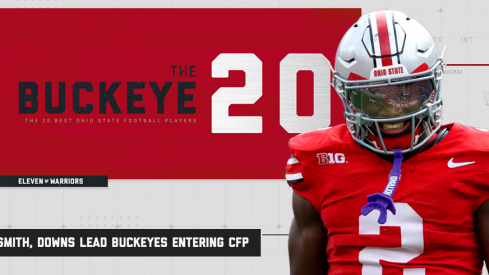“It’s just a glorified practice.”
While it may be true in the sense that this Saturday is technically one of the 15 designated practices the NCAA allows each program during the spring, there is still much that we can learn from what the young men in scarlet and gray (and in some cases, black) jerseys will show us in they return to the Horseshoe for the 2014 rendition of the Ohio State Spring Game.
In an effort to prepare you to speak knowledgeably to your fellow Buckeye, here are a few things to watch for if you’re one of the thousands of fans either in the stands, or watching from home.
Offense
QUARTERBACKS
With shoulder surgery turning Braxton Miller into Ohio’ most talented spectator this spring, Cardale Jones has had the opportunity to run the starting offense as he prepares to replace the greatest backup QB in school history this fall. While Jones played in 3 games last season, rushing 17 times for 128 yards and a touchdown, he only attempted 2 passes in that time.
After spending the past month working with the rest of the first team, the initial question (as it is with anyone new playing the position) is how quickly and accurately he is able to get the ball to his receivers. Given the youth in the OSU secondary, I wouldn’t be surprised to see Jones connect with Devin Smith on a deep ball, potentially more than once on Saturday.
However, what will be critical to his future in the Meyer/Herman offense is his ability to quickly make good decisions. Arguably, Guiton’s best attribute was correctly keeping or distributing the ball in both the passing game, as well as on option runs:
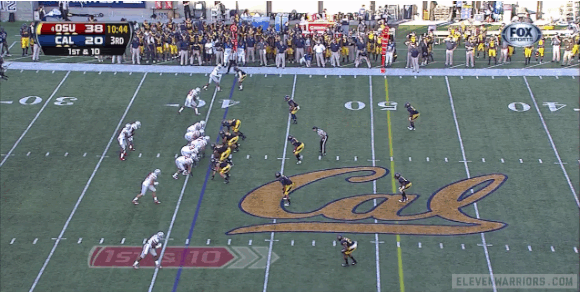
Even though the quarterbacks will likely wear their black “no-contact” jerseys on Saturday, I expect to see a multitude of read-option plays called, as they are such a foundational piece of the Ohio State offense. Meyer and Herman aren't going to stop asking the quarterback to decide to keep or give the ball on running plays anytime soon, so Jones must be able to properly identify the option defender and make the correct decision.
Similarly, this will be the first time many Buckeye fans will get to see highly touted Redshirt Freshman J.T. Barrett in action. All of what applies to Jones also applies to Barrett. If there truly is going to be a competition in fall camp for the backup QB role, Jones has a clear upper hand at this point by running with the starters all spring. For Barrett to have a chance at seeing the field this fall in any meaningful capacity, he’ll have to show that he can make decisions just as well, if not better, than Jones.
THE RUNNING GAME
For the past two seasons, the Ohio State offense was built around the inside zone running play, with the perfect back to run it in Carlos Hyde. With the loss of ‘El Guapo” and 4 offensive linemen, it remains to be seen if that play will remain the lynchpin of future OSU game plans.
While many people will focus on which player is receiving the handoff, your eyes should be on the offensive line. I expect there to be a great deal of inside zone, but Ohio State has also occasionally run the old “Power” play (yes, Dave is still alive and well) under Meyer and Herman, albeit only on occasion and against certain opponents more than others. Watch the guards to identify this concept, as the backside guard will pull and lead the running back through the hole and give the offense a numbers advantage on the play-side:

Additionally, OSU has not run much Outside Zone since Meyer took over. This may be a personnel issue, as you often need better athletes on the offensive line to successfully block this scheme, but with 4 of 5 members of the line seeing their first time in the starting lineup, this is as good a time as any to experiment and determine if the Outside Zone can be successfully implemented. The easiest way to identify Outside Zone is the first step that the line takes after the snap:

The entire line will take a lateral step in unison to one side, using leverage to move defenders toward the sideline, and eventually creating a cutback lane for the running back. With the quickness and ability to change direction of backs like Ezekiel Elliot, this scheme may be better suited to their game that that of Carlos Hyde.
Being that the Spring Game is a opportunity to focus on your core philosophies, this should tell us if Inside Zone is still the king of the Ohio State playbook. OSU will option the QB off these core schemes, as well as package these runs with short passes and screens, but everything still relies on the Offensive Line’s ability to consistently block one or all of these concepts.
Defense
THE COVER 4
If you haven’t heard, Ohio State hired Chris Ash as new Co-Defensive Coordinator. Nearly every contributor to 11W has touched on what this may mean for the Buckeyes, but this Saturday is the first time many of us will get to see his changes with our own eyes.
The most important change we’re likely to see is a switch in philosophy for the Defensive Backs, going to from running a number of different zone coverages to an aggressive, man-to-man defense run out of a cover 4 shell.
For those of us unable to watch from within the Midwest’s most beautiful cathedral, it may be difficult to watch how pass routes develop, and are thus covered, when watching on TV (brought to you by Rotel). However, the way the defenders line up before the snap, as well as how the corners react within the first few steps can tell us a lot about the differences in Chris Ash’s system.
As I’ve discussed before, Ash’s DBs lined up almost exclusively in this alignment last season at Arkansas. The safeties are each lined up on a hash mark, roughly 10 yards from the ball. The depth of the cornerbacks can vary, going from nearly parallel to the safeties, to right on the line of scrimmage across from the opposing receiver.
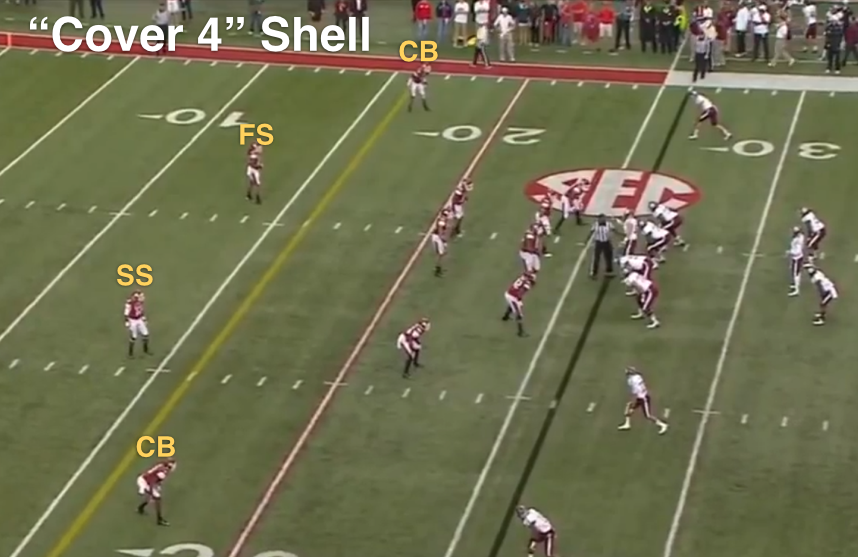
This does not mean that his teams ran the Cover 4 zone exclusively, though. Ash will run a number of coverages from this alignment, both man and zone. The important takeaway here is that the Buckeye back seven should hopefully now be comfortable in the alignment on every snap, and spending their time diagnosing their opponent instead of worrying about their own play-call, a well-known problem that plagued the 2013 squad. Ash has the task of finding 3 new starters in the Defensive backfield, and much like their counterparts on the offense, their progression starts with the basics.
MAN VS. ZONE
Once they get lined up though, these youngsters will have a lot of responsibility, likely finding themselves covering the likes of Devin Smith and Dontre Wilson in one-on-one coverage. While it’s common for NFL defensive backs to find themselves in these situations, it’s less so for 19 year olds on the college level.
Often, it may appear that a college defender is in “man” coverage on deep passes, when they’re the only defender near the receiver. However, more often than not that player is playing a deep zone coverage. Additionally, many fans assume that when they see a defender line up just across the line from a receiver, and then jam him at the line, they must be in man coverage as well. In this instance, it’s also likely that the defense is running a zone coverage, such as a Cover 2 scheme (that is often run by teams that line up in Cover 4 shells), but also from the Cover 6 (quarter-quarter-half) scheme that OSU ran quite frequently.
To truly determine if Buckeye defenders are running man-to-man (especially if watching from home), one must watch their eyes. One of the few teams to successfully run man coverage (especially out of the Cover 4 shell) at the college level is Alabama. As seen in their matchup against Texas A&M last fall, not every Alabama defender was lined up right across from their assigned receiver:
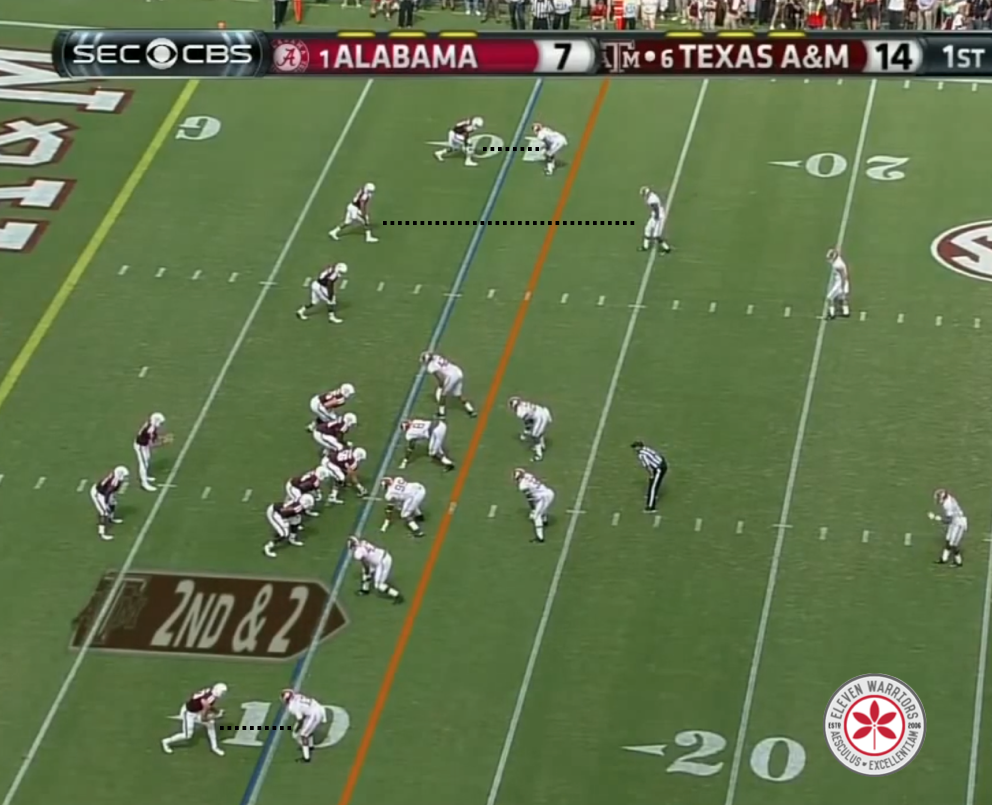
At the snap, the eyes of the defender aren’t on the action in the backfield, and are locked on to following their receiver:
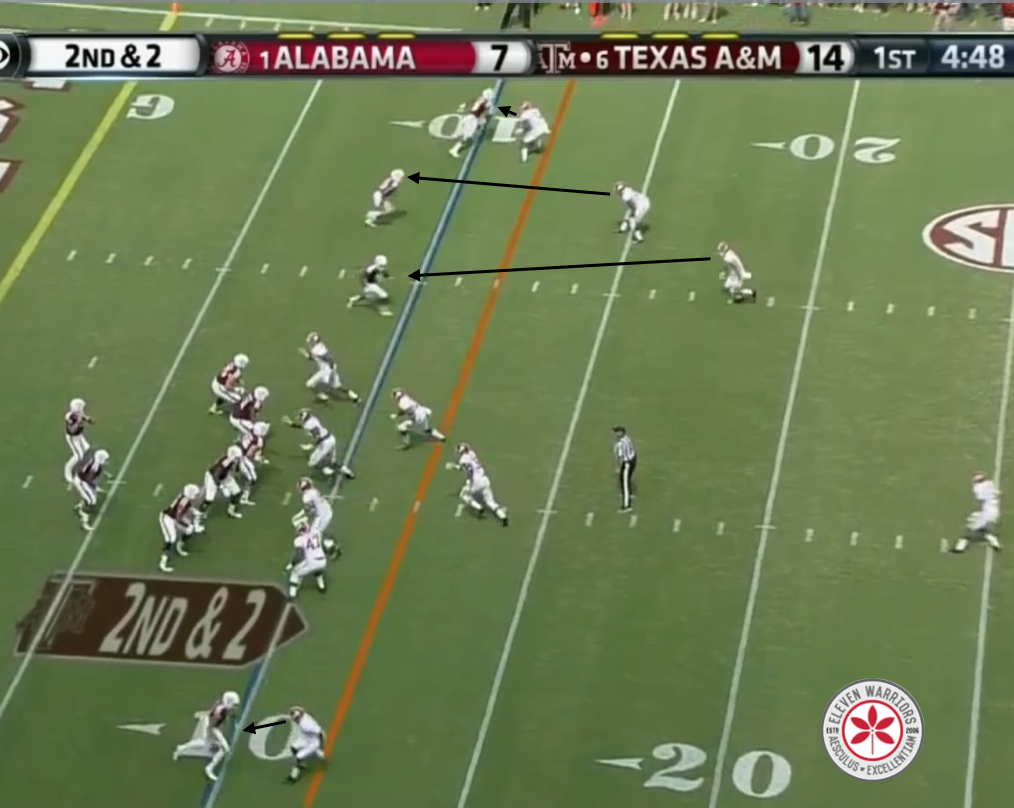
Due to TV camera angles, this is often all a fan at home gets to see of pass coverage until the ball arrives. For those of you in the stadium, it’s much easier to watch how the defender positions himself as the play progresses.
For years, Ohio State fans have been craving an aggressive scheme from the secondary, mirroring that of the Seattle Seahawks. Having 2 of the best defensive backs on the planet allows the Super Bowl champs to run such a scheme at a level that we shouldn’t expect to see from a group of 18-22 year olds. But running this scheme will be critical to the success of the Buckeyes moving forward, as man coverage is looked at as the best way to defend the run/pass packaged plays that Urban Meyer himself acknowledged are appearing more and more across college football.
Theoretically, the offense wants to force a defender into making a decision of covering either the run or the pass, and then acts accordingly to make that defender wrong every time. When a defender is assigned a specific man to defend, that decision is gone. By Meyer’s estimate, nearly half of all teams will be running the packaged play concepts, meaning this is an issue the Buckeye defense will need to be prepared for, not only on Saturday, but in autumns to come as well.
So, while all your friends are talking about the latest 3rd string wide receiver to be named unofficial MVP after the game, hopefully now you’ll get to sound like the nerdiest smartest guy in the room when talking about this year’s rendition of the Spring Game.
